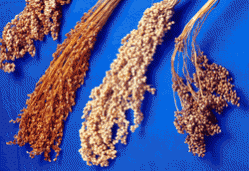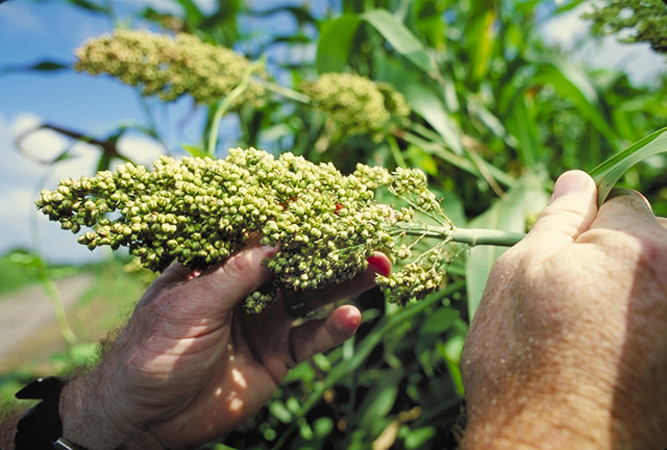Each month we feature a different whole grain on the Whole Grains Council website, including information on its health benefits, cooking tips and recipes, historical/cultural facts, and more. Click to see the full calendar.
June’s Grain of the Month is Sorghum. It is surprising, considering that sorghum is the fifth most important cereal crop in the world, that it is a largely unknown grain in America. Sorghum’s global importance is largely due to its natural drought tolerance and versatility as a crop. In Africa and parts of Asia, sorghum is primarily grown for human consumption while in the United States it is used mainly for livestock feed and ethanol production. Consumer knowledge of sorghum is on the rise with the increasing popularity of plant-based and gluten-free foods, and those trying it are loving what they have found so far.
SORGHUM
The genus Sorghum contains 25 different species, more than half of which are native to Australia, with other species originating in Africa and Asia. The only cultivated species of sorghum is Sorghum bicolor, which originated in Africa. Depending on the variety, Sorghum bicolor can grow up to 15 feet tall on
hearty stalks, and produces spikelets of white, yellow, red, or brown grain seeds. As a plant, sorghum has an impressively diverse set of use cases. It is grown for biofuel, animal fodder and forage, and in some places its stalks and fibers are used for building materials, brooms and brushes — in fact, one of its colloquial names is broomcorn. Sorghum is also grown for its sugar content. Much like sugar cane, another member of the Poaceae or grass family, sweet sorghum has a sugar-rich stalk which is crushed for its sugary juice. At one point, sweet sorghum was the number one table sweetener in the US but much like molasses, modern global trends relegated sorghum syrup to the southern parts of the continental US.
Sorghum is adapted to a wide array of environments, grown in the tropics as well as in arid regions of the world. As a C4 plant, sorghum is efficient at fixing carbon in high-temperature and low-moisture environments. Conversely, it is sorghum’s tolerance of waterlogging that helps it thrive in tropic environments. Sorghum matures quickly, some types in as little as 75 days, and can provide up to three harvests a year. Its adaptability and diverse use cases propelled Jack Harlan, a famous botanist, to proclaim that “sorghum is one of the really indispensable crops” required for the survival of humankind (From Jack Harlan, 1971).
Click here to see more sorghum photos.
HISTORY
The earliest evidence of sorghum in the archeological record is from Nabta Playa, an 8,000-year-old Neolithic site in Africa. Sorghum’s wide distribution across the structures uncovered at Nabta Playa is evidence that, at a minimum, sorghum grew in the area and was gathered by the nomadic tribes stopping there. Alternatively, there is the potential that sorghum was cultivated at Nabta Playa, having travelled to the site from another area with the nomadic tribes and then been purposefully planted. Regardless, it was not until much later that cultivated Sorghum bicolor traveled out of Africa through established trade routes into Southern Asia. It is largely agreed that African crops, such as sorghum, traveled out of Africa and had reached the Indus Valley by 2000 BC, though some sources feel there is enough genetic and linguistic evidence to place the introduction of African plants to the Indus Valley as early as the middle of the 3rd millennium BC. Once introduced, Sorghum quickly moved through India into China, perhaps almost simultaneously with the grain’s introduction into India itself.
The first known record of sorghum in the United States comes from Ben Franklin, who in 1757 wrote about its application in producing brooms. Far from its broom-producing beginnings, today the United States is the top producer of sorghum globally. Sorghum is predominantly grown from South Dakota to Southern Texas in what is known as the Sorghum Belt. In 2018, 365 million bushels of sorghum were harvested in the US. While the top three markets for US sorghum are ethanol, livestock feed, and exports, an increase in demand for plant-based and gluten-free foods has led to more opportunities to grow sorghum for the consumer food industry.
NUTRITION
Sorghum has high antioxidant levels compared to other grains and vegetables and contains an impressive mix of phytochemicals. These phytochemicals may help
control cholesterol levels, and sorghum’s high phenolic content and high antioxidant properties have been shown to impact advanced glycation end products, which have been implicated as a complication of diabetes. In another limited study sorghum was found to elicit a low glucose response in healthy individuals suggesting that sorghum may be helpful in managing glucose and insulin levels. And remember, if you have celiac disease, sorghum is one of many great gluten-free grain options!
Each whole grain offers a different mix of nutrients. Sorghum provides a good source (providing at least 10% of the recommended daily value) of fiber, magnesium, phosphorus, and vitamin B3 and is an excellent source (providing at least 20% of the recommended daily value) of manganese.
TIME TO EAT!
When thinking about how to prepare sorghum always remember: it can be popped!
Slow-cooker Sorghum Jambalaya Chicken
Split Pea and Sorghum Salad with Swiss Chard and Spiced Tahini Dressing





